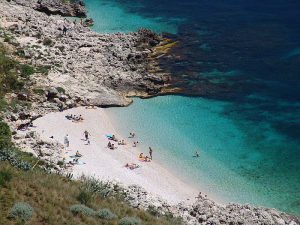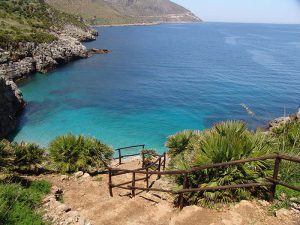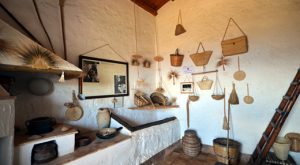Especially in the summertime, it is nice to discover unspoilt places, which preserve nature in its purest state. This time we take you to a protected area, a green area, characterised by a transparent, crystal-clear blue sea, white beaches, pebbly coves, natural beauties, caves, creeks, rocks, old farmhouses and a huge variety of flora and fauna.
How the Reserve extends
In just seven kilometres of coastline, you can enjoy a unique, unforgettable experience: the Zingaro Nature Reserve, which stretches in the western part of Sicily between San Vito Lo Capo, to the north, and Castellammare del Golfo, to the south, was the first nature reserve established by the Region of Sicily in 1981, which took up the demands and protests of young national and international environmental movements against an attempt to cement and subdivide the coastline.

This place, one of the most famous in Italy, open daily from 7 a.m. to 7.30 p.m., offers visitors a variety of breathtaking scenery and leaves them enchanted and fascinated by its originality and rugged beauty. Considered one of the few remaining terrestrial and marine natural paradises in Europe, the Reserve covers an area of 1650 hectares, home to dwarf palms, lush Mediterranean scrub, wild olive trees, almond trees, carob trees, orchids, ash trees, cork trees, limonium, euphorbia and mastic trees, and was known to the ancient Greeks and Romans as Cetaria because of the abundance of tuna found in its waters.
The fauna of the Reserve
The fauna present is also interesting. Some 40 bird species nest and breed here, mainly birds of prey, including Bonelli’s eagle, kite, peregrine falcon, kestrel, owl and buzzard. Other birds include the imperial raven, the lonely sparrow, the rock partridge, the crow, the magpie, the owl, the tawny owl, the barn owl, the great tit, the little wren and eight different species of bat.
Animals include the rabbit, fox, weasel, hedgehog, porcupine, viper, gecko and lizard. Tourists can gain access by sea or by land by following three paths, the first, the coastal one, is the most popular and the easiest, connecting the southern entrance with the northern one, and is about seven kilometres long, which can be covered in a couple of hours.
The second, the mid-coast path, of medium difficulty, is the most scenic, and is eight and a half kilometres long, which can be covered in four and a half hours. The third, the high path, the most demanding, crosses the entire Zingaro, is 17 kilometres long and takes about seven hours, and is recommended for the more athletic, especially for trekking enthusiasts and experts.

The Reserve can also be reached from the sea by dinghy or boat, a unique opportunity to see beautiful beaches, clear seabeds rich in fish, tunnels and underwater caves such as the Grotta del Colombaccio, the Grotta della Corvina, the Grotta della Capreria the Grotta della Mustia, the Grotta della Ficarella and the prehistoric Grotta dell’Uzzo, site of one of the earliest prehistoric settlements in Sicily, where evidence of life eight thousand years ago can be found, a real attraction for snorkelling enthusiasts.
The most popular beach is the Cala Tonnarella dell’Uzzo, while narrow, hidden paths lead to the famous ‘calette’, shallow-water inlets with small white pebble beaches, immersed in the Mediterranean maquis. Wonderful is the Cala Torre dell’Uzzo, isolated is the Cala Marinella, characteristic are the Cala della Capreria, Cala del Varo, accessible from the sea, Cala della Disa or Zingaro, and Cala Berretta.
Instead, if you head for the mountains, you can reach the summit of Monte Passo del Lupo (868 m), Monte Speziale (912 m), Monte Scardina (692 m), Pizzo dell’Aquila (759 m) and Portella Mandra Nuova (717 m). In the territory of the Reserve there are anthropologically relevant realities such as Borgo Cusenza, a small group of houses, inhabited by shepherds and peasants, abandoned in the early 1950s, skilfully recovered by the Reserve, and five small museums: The Naturalistic Museum which, through photographic panels, illustrates the flora, but also the fauna, of the Reserve, there are medicinal plants, used in local medicine, and reproductions of animals built with a very refined technique.

Museums
The Manna Museum, inside a cave with a few old tools for collecting and preserving ash, from whose bark manna is extracted, edible sap that is collected in the summer, between July and September, and is used as a natural sweetener but also as a laxative. The Museum of Braiding, dedicated to local handicrafts including hats, rings and necklaces made from the use of certain seeds and the famous coffees, now used as bags and finished with fabrics and other decorations.
The Museo della Civiltà Contadina (Museum of Peasant Civilisation) displays tangible signs of wheat processing, with ploughs, scythes, saddlebags and pasta-drawing tools, earthenware pots and vessels, bummuli, containers used to keep water cool in hot weather, and muscalori, round fans made from a weave of dwarf palm stitched together and attached to the end of a cane, used to keep charcoal alive.
The Maritime Activities Museum, housed inside an old marfaraggio, as it was called in the tuna fisheries, the complex of buildings used for tuna processing, the storage of fishing gear and accommodation for the fishermen who worked the fixed nets seasonally. On display are nets and creels, used for the mattanza, and photographic images illustrating how bluefin tuna fishing was a ritual and an honour, but also a duty and survival.
How to access the reserve
The reserve can only be visited on foot, and is recommended for diving, trekking, cycling and hiking enthusiasts. It is necessary to wear appropriate clothing, equipment and comfortable shoes, a hat, water and food, pets are not allowed, it is forbidden to enter with beach slippers, flip-flops or shoes with heels, it is not possible to bring chairs, deckchairs, sunbeds, umbrellas or inflatable boats, it is necessary to stay more than 300 metres from the shore with motor boats running, and it is forbidden to soil or pollute.
Along the trails, for a short break or even to spend the night, it is possible to come across refuges, available from October to May for no more than two nights and for which permission must be sought in advance from the Reserve. A curiosity? The only possible means of transport is by mule. The Zingaro Nature Reserve is open all the time: every day from 7 a.m. to 7.30 p.m.
foto credits:http://www.sanvitoweb.com

